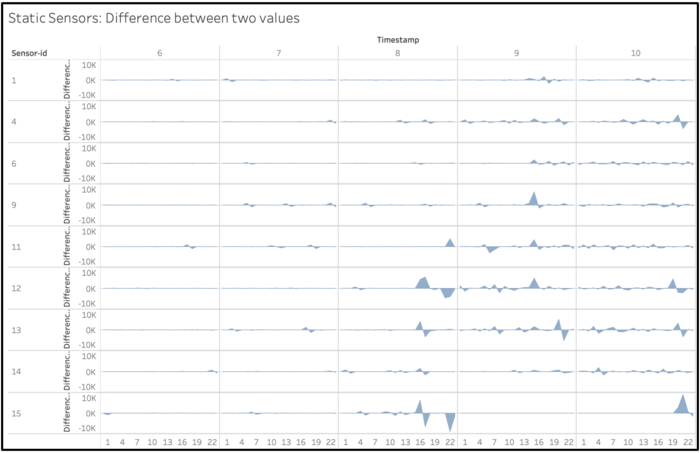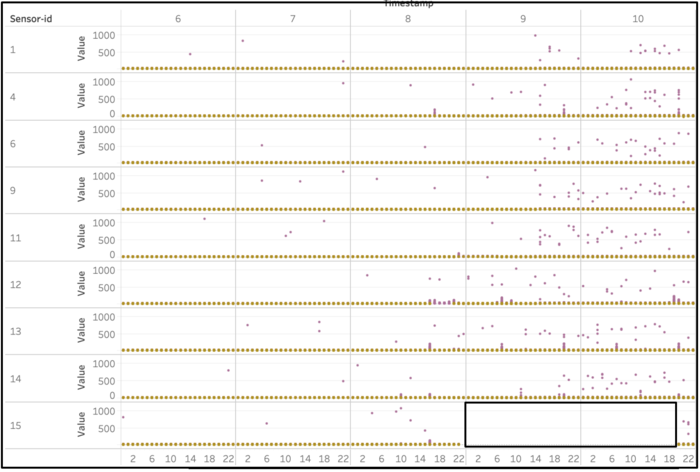IS428 AY2019-20T1 Assign Sean Chai Shong Hee Q2
This section will answer questions for Mini Case 2
Contents
Question 2
Calculated fields
Two calculated fields were created during the data preparation phase:
| Calculated Field Name | Formula | Explanation |
|---|---|---|
The calculated field Value > Average Value will help determine if the value recorded is higher than the average recorded radiation value of the neighbourhood for a particular day.
Certainty of static sensors
Before carrying out visualisations for the uncertainty of static sensors, I wanted to first find out the certainty of static sensors. This was done by visualising the variation in values recorded by static sensors.
The area chart shows how values recorded by the static sensors vary with the previous value recorded. Here, we can see the variations in values recorded. Generally, there is little variation between consecutive values recorded. This indicates that the static sensors are consistent in their measurements of radiation values.
Uncertainty of static sensors
Monitoring activities for static sensor 15 ceased from 8th April at 10pm and only resumed on the 10th of April at 8pm. Static sensor 15 may have malfunctioned due to exposure to high levels of nuclear radiation. Being situated at the entrance of the nuclear power plant, static sensor 15 would have been exposed to the heaviest dose of radiation leakage. The pattern of malfunction is also consistent with the behaviour of many of the mobile sensors. A number of mobile sensors suffered malfunctions during the same time period.
Uncertainty of mobile sensors
A graph was plotted to determine sensors whose recorded radiation values were higher than the average radiation values of the neighbourhood where measurements were made.
I observed a significant amount of missing values at identical time intervals from 9th to 10th of April. The occurrence of malfunctions in mobile sensors at similar time intervals suggests the presence of large amounts of nuclear radiation. Nuclear radiation can cause effects similar to electro-magnetic pulses, which disrupts the operations of electronics. In this case, it may have caused mobile sensors to malfunction.
The theory of mobile sensor's exposure to radiation leakage is further substantiated by the fact that values of radiation levels higher than that of the average value recorded in the neighbourhood was observed. Specifically, when mobile sensors 20,21,22,24,25,27,28,29,45 and 46 came online at around 6pm on 9 April, their readings were higher than the average value recorded for the day. These mobile sensors might have been contaminated by the radioactive leakage. Values from these sensors taken between 8pm on 9 April and 8am on 10 April are too uncertain to trust.
There were values for mobile sensors taken for locations outside of the city as well. These measures gave an inaccurate representation of the values that were above the average values taken in the neighbourhood. Hence, these values were filtered out.
Regions in city with higher uncertainty of radiation measurements
Factor 1
The main factor contributing to uncertainty in radiation measurements is the distribution of sensors. Some regions might have lesser sensors, which makes it difficult to visualise how radiation varies in the region. It also make it difficult to cross validate the data.
From the visualisation, I have determined that the following neighbourhoods are the most uncertain:
Firstly, these neighbourhoods do not contain any static sensor. Secondly, mobile sensor coverage is limited as few distinct mobile sensors pass by these regions. Thirdly, the total number of data collected in these regions are the least.
Factor 2
A secondary cause of uncertainty in radiation measurements is due to radioactive contamination. Following radiation leakage after the earthquake, some mobile sensors were contaminated, which led them to have readings constantly higher than the average readings of the neighbourhood.
I am particular interesting in measurements of values that are higher than average after a period of inactivity. Inactivity is demonstrated by missing values in the visualisation.
The readings in the following regions are more likely to be uncertain due to contamination by mobile sensors:


